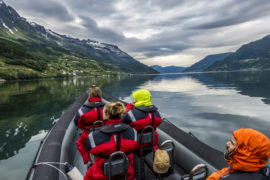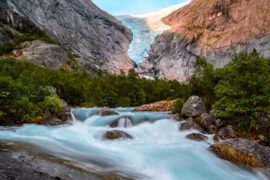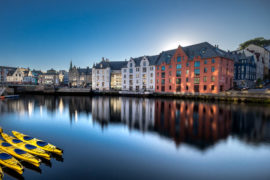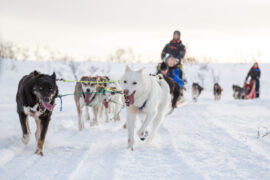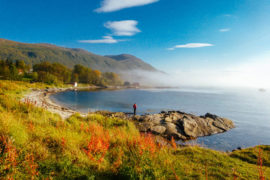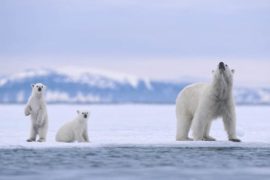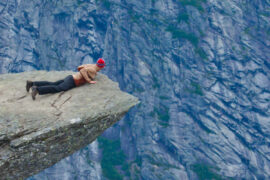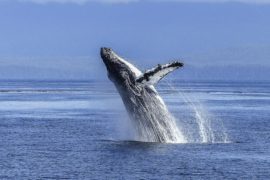Camping in some of the world’s most dramatic terrain is one of the best things about a trip to Norway. And the bonus: it keeps costs down in what is otherwise an expensive country to travel around.
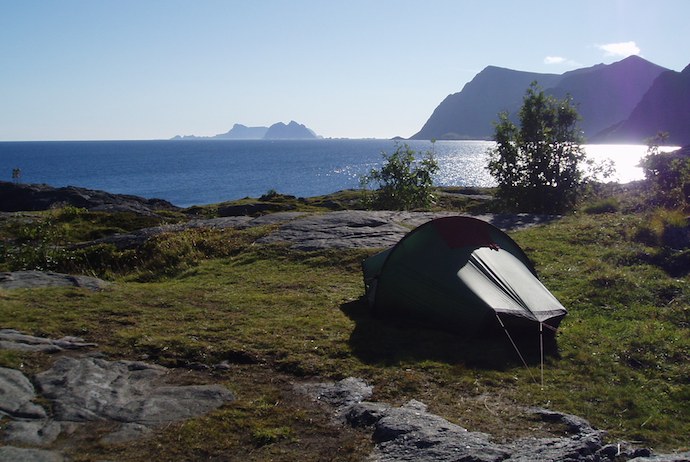
But it’s not all about saving money. There’s nothing like listening to the call of oystercatchers and lapping waves from the comfort of your sleeping bag.
Or waking up with the sun, sticking your head out of your tent and taking in the grandeur of your surroundings, fjords and all.
So what’s the best way to go camping in Norway? And where should you pitch up?
The main choice to make is whether you want the facilities of an organised campsite, or whether you’re prepared to rough it and carry more stuff with you, including food and water.
Wild camping in Norway
So, where is camping allowed in Norway? Well, the good news is that wild camping is allowed almost everywhere.
And with a fjord or a lake just a few steps away, you can freshen up with a dip in the morning – it gives an endorphin rush like no other to start the day.
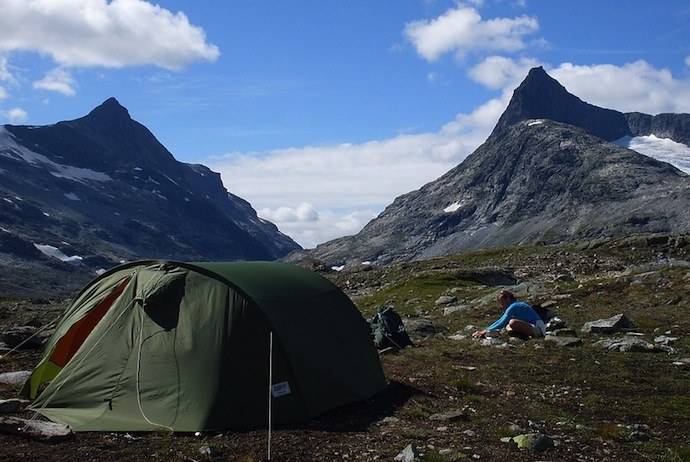
A longstanding law called allemannsretten (loosely translated as ‘the right to roam’) allows everyone to wild camp virtually anywhere in open country, for free.
It gives fantastic freedom, with a few common-sense provisos, so that you don’t upset the landowner or annoy other people enjoying the countryside.
The golden rules for camping wild in Norway
- You can camp for up to two nights on any stretch of uncultivated land without asking permission from the landowner.
- This right applies to camping in open country only, not farmland under cultivation, hay meadows, or young plantations and regenerating forest. If in doubt, look for another spot.
- Your pitch needs to be 150m away from the nearest house, cabin or other building that’s being occupied or used. You can’t set up camp on someone’s lawn or the plot around a holiday home.
- In remote areas, you don’t need to seek permission for longer stays as long as it doesn’t cause inconvenience and you’re not close to busy walking trails or touristy spots.
- In return for pitching up in the wild, you’re asked to respect nature and wildlife and leave no litter or other trace of your stay.
Frequently asked questions
Can I camp near cities?
Yes, as long as you respect the rules listed above. Langøyene island, a 15-minute ferry ride away from Oslo, has grassy glades to pitch up in, right next to the fjord. Sognsvann lake, north of Oslo, is another good spot.
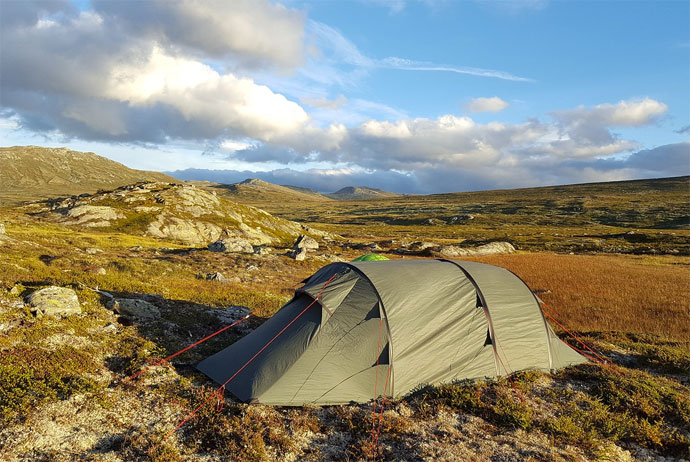
Can I swim in lakes and fjords?
You can swim wherever you want in Norway, except in sources of drinking water, which are usually well signposted. Just respect the rules about not getting too close to people’s houses or private jetties.
Can I go foraging?
The same right that allows everyone to camp wild also covers foraging; everyone’s free to collect berries, herbs and mushrooms in the wild.
One serious point: make sure you know what you’re picking so you don’t end up poisoning yourself.
Special rules apply to cloudberries, a highly prized, yellow berry that looks a bit like a raspberry and which grows in marshy areas of the Arctic Circle.
They fetch a high price per kilo and some landowners are entitled to fence off their land and forbid picking. In other places you can pick with prior permission: it’s best to check with locals.
Can I go fishing and eat what I catch?
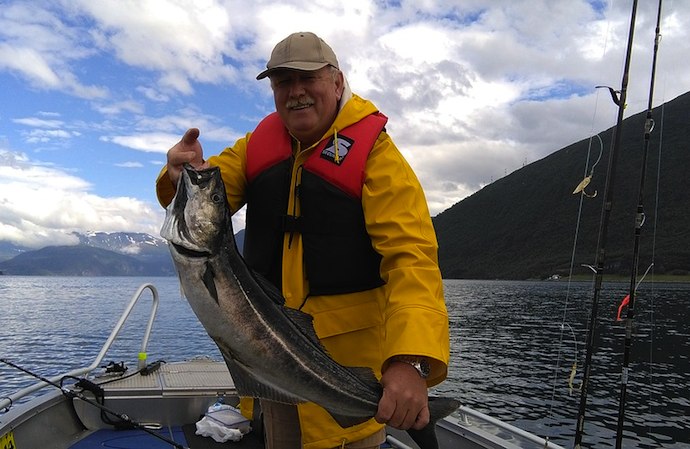
You can fish in the seas off Norway, as long as you use handheld tackle (so leave that trawler at home!).
You can use these saltwater fish for your own consumption. There are however a few protected species which you’re not allowed to catch.
For freshwater fishing, you should buy a permit locally. Alternatively, check out inatur.no before you arrive.
Can I bring a car or motorbike?
As long as you stay on public roads and park without causing an obstruction, cars and motorbikes are okay. Off-roading is generally a no-no.
Can I make a campfire?
From 15 April to 15 September, there’s a general ban on open fires and disposable barbecues in the wild. But if your campfire clearly poses no risk of starting a wildfire – for example, if you’re on a beach – it’s allowed.
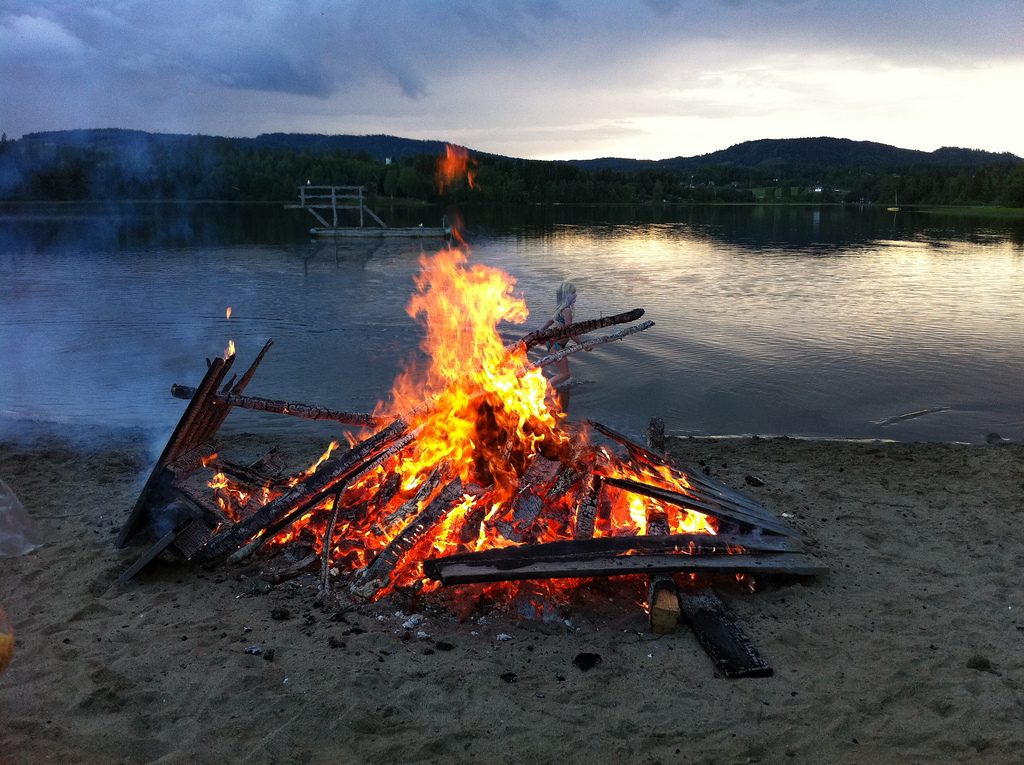
During droughts, there may be a complete ban on all fires including stoves, so check conditions at the weather site yr.no and ask around locally.
Am I free to cycle or ski wherever I like?
The ‘right to roam’ applies to mountain biking and skiing, too – but respect any local signs that forbid it. Additionally, skiiers have the right to roam on cultivated land from 15th October to 29th April, when it’s covered in snow.
Is hunting allowed?
Wild reindeer, deer, wolves, beaver and elk are all hunted in Norway, with different district authorities allowing culls or setting open seasons at various times of year.
Check the state of play locally, because you can’t wild camp during hunting seasons for safety reasons. The Norwegian Directorate for Nature can tell you more.
Is it safe to wild camp in Norway?
Provided you follow the golden rules of wild camping, it should be perfectly safe. Obviously, you should be careful not to set up too close to a river or a lake, especially if it’s raining, and take care to find to find a safe, flat site.
Do your research beforehand: check the weather forecast: check whether it’s the hunting season; and ask locals about the possibility of any wild animals in the area.
Elk and reindeer are the most common wildlife when camping in Norway, but there are also bears and wolves and, though they are incredibly rare, you don’t want to risk them sniffing around at night outside your tent.
Make sure you bring suitable equipment for the weather and the terrain, plus mosquito repellent in summer.
And always tell someone where you are heading for, and when you are due to return, especially if you’re going off-the-beaten-track.
Do I really need travel insurance?
Norway is a safe place but you still need travel insurance. It can make all the difference if things go wrong when you’re in the middle of nowhere. World Nomads provides travel insurance for travelers in over 100 countries. As an affiliate, we receive a fee when you get a quote from World Nomads using this link. We do not represent World Nomads. This is information only and not a recommendation to buy travel insurance. Read more about buying travel insurance in this guide.
Is it possible to camp wild in winter?
Unless you’re hardcore and have expedition-grade gear, you might want to think about ‘indoor camping’ in a DNT or campsite cabin instead – they’re well set up for winter stays.
See below for more on the network of DNT cabins around the country.
Camping wild in the snow is definitely possible, but you should take survival courses before setting off, pack well, and make proper plans to ensure you stay safe.
Where do I go to the toilet while camping?
Hikers often drink from streams, so do your business at least 50m away from water sources. Make sure you bury any solids and the corresponding paperwork.
Where can I buy outdoor gear?
Biltema, Clas Ohlson and XXL are all good value and have stores in most Norwegian towns.
If you’re looking for Norwegian tents, brands such as Nortent make good quality lightweight trekking tents, while Tentipi make extreme-condition Nordic tipis, based on the original Sami tents.
If you run out of camping butane or propane, you’ll often find it for sale in petrol stations.
Can you park your campervan anywhere in Norway?
The 150m rule mentioned above applies to campervans, RVs and caravans too, as long as you’re off the road.
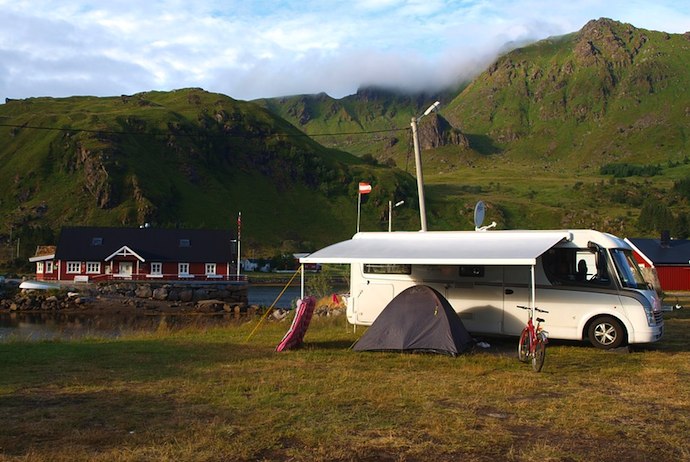
There’s a network of rest areas across Norway and you’ll find allocated overnight parking places in most towns. Sites like Campstar let you book campervan hire in Norway.
Tømmestasjon or ‘Dump stations’, where you can empty chemical toilets and fill up with fresh water, are frequent and well signposted – you’ll find them at most petrol stations and overnight parking spots.
Can you camp in the fjords?
Camping in Norway’s fjords is definitely possible. In fact, camping in western Norway is one of the best ways of exploring the region, especially if you’re on a budget.
If you want to camp wild, the same rules apply as in the rest of Norway. And if you’re looking for a campsite there are some great options available.
Camping in Bergen makes a great base for exploring Norway’s fjord land, and there are several sites that are close to the facilities of the city, but still in picturesque rural surroundings, such as the lakeside Bratland Camping.
Or, for somewhere more remote, there’s Dalsoren Camping in the heart of Norway’s fjord land on the shores of the Lusterfjord, while Camping Kinsarvik Norway is a good site from which to explore the Hardangerfjord.
Alternatively, camping in Voss, Norway’s extreme sports capital, can be an exhilarating adventure. Voss Camping makes a good base from which to try some high-adrenaline activities, such as base-jumping or para-gliding.
Campsites in Norway
If the thought of a lonely night under the stars miles from anywhere – and anyone – fills you with dread, don’t worry. Norwegian campsites offer convenience and relative comfort.
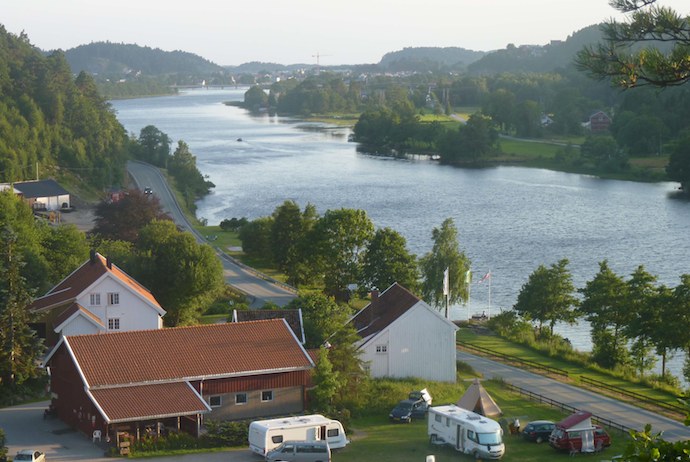
In Norway, camping cabins are very popular and, as well as pitches for tents, most campsites have a few cabins for rent sleeping two, four or more – handy if the weather’s foul, your gear’s soaked through and you need to dry off.
There are 1,000 or so campsites dotted across Norway, classified by a star system.
One-star sites are pretty basic, with self-catering facilities and hot and cold running water, while five-star sites come with shops, TV rooms, kids’ play rooms, washing machines and other amenities.
A good way to find some of the best camping in Norway is to browse the campsites on Booking.com, which lists most of the country’s best campsites from Alta River Camping Norway in the far north to Camping Elverum in the east of Norway towards the border with Sweden.
Also worth knowing about is the network of 550 huts run by the Norwegian Trekking Association (DNT).
Their stone bivvy shelters and self-service cabins are in the most beautiful areas for hiking, mountain biking and skiing. There’s more on how to become a DNT member, when huts are open and how to get hold of a master key at dnt.no
How much does camping cost in Norway?
Of course, if you have your own tent and are camping wild, it’s completely free.
But, if you’re at a campsite the price will vary depending on the location, the time of year, the facilities and whether you’re in a tent or an RV.
If you’re planning on doing a lot of camping outside of high season, buying a Camping Card Norway could save you money. It costs €22 a year and gives discounted rates at campsites around the country in low season.
So, we’ve checked out some prices for camping in Norway, and here’s a rough guide to what you might expect to pay. Note that we’ve given average price – upmarket campsites will charge more and basic sites with few facilities will be cheaper.
Campsites in Norway | Typical price |
| A tent plus two people (low season) | 250 NOK |
| A tent plus two people (high season) | 350 NOK |
| RVs/camper vans (low season) | 350 NOK |
| RVs/camper vans (high season) | 500 NOK |
| Showers | 10 NOK extra |
Five special campsites in Norway
We’ve picked out some really special campsites around the country, and here are our five favourite campsites in Norway.
Hammerstad Camping
In a peaceful spot next to the Austnesfjord, Hammerstad Camping is a small site, a 10-minute drive from Svolvær, the self-styled ‘capital’ of Lofoten.
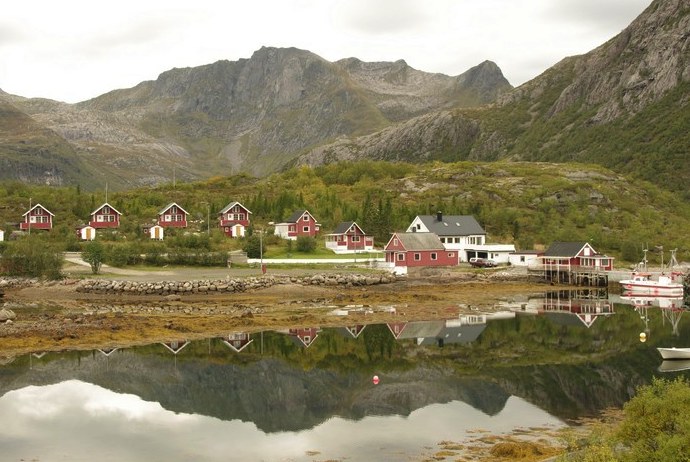
The fjord is teeming with fish, so attempting to catch them is what most people do here – or you can rent a boat with an outboard motor and tootle around the inlets.
The site has cabins to rent with views of the sea as well as camping pitches.
Bøflaten Camping AS
With plenty of grassy pitches for tents and camper vans plus some comfortable wooden cabins to rent, this campsite is in an unbeatable location, beside lake Vangsmjøse.
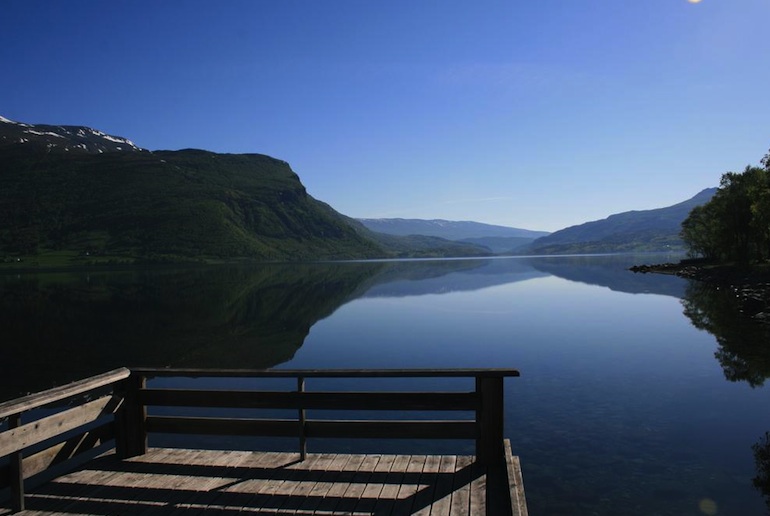
It’s a good family site, with a private sandy lake beach, table tennis and woods for kids to play in, but you can also rent fishing boats and kayaks, as well as bikes for exploring the surrounding countryside.
Bøflaten makes a great base for setting out on some mountain hikes too, or even skiing in winter.
Melkevoll Bretun
There’s plenty of space for tents and campervans on lush, green pitches or in turf-roofed cabins at Melkevoll Bretun, 190 miles from Bergen at Briksdalen on the doorstep of the Jostedal National Park.
A ‘kitchen barn’ and free sauna are among the facilities, with loads to do including bouldering (there’s a natural course on site) and hiking – the Briksdal glacier is a 45-min walk away.
Rystad Lofoten Camping
With grass-roofed wooden cabins and wide open grassy spaces for camper vans and tents, this coastal campsite in the Lofoten islands couldn’t get much closer to the beach if it tried.
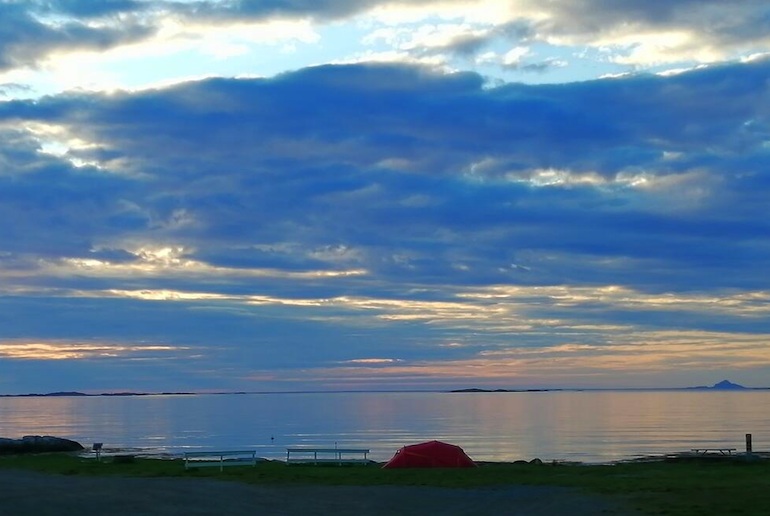
With a backdrop of mountains, it’s a peaceful spot with a wild and remote vibe – perfect for those who want to get back to nature.
There are picnic benches dotted along the shoreline so you can settle in and watch the midnight over the sea and mountains.
Skrolsvik Kystferie
Senja in the Arctic Circle is Norway’s second biggest island, famous for sea eagles in summer and whale watching in winter. Skrolsvik Kystferie is a glorious waterfront site here, with tent pitches, RV sites plus a few cabins.
It’s a 40-minute drive from the Ånderdalen National Park, a protected stretch of Alpine coastal forest, fjords and lava fields criss-crossed by hiking trails.
You can browse hundreds of other Norwegian campsites here.
See also:
Camping in Sweden
Seeing the northern lights in Norway
The best places to stay in Norway

